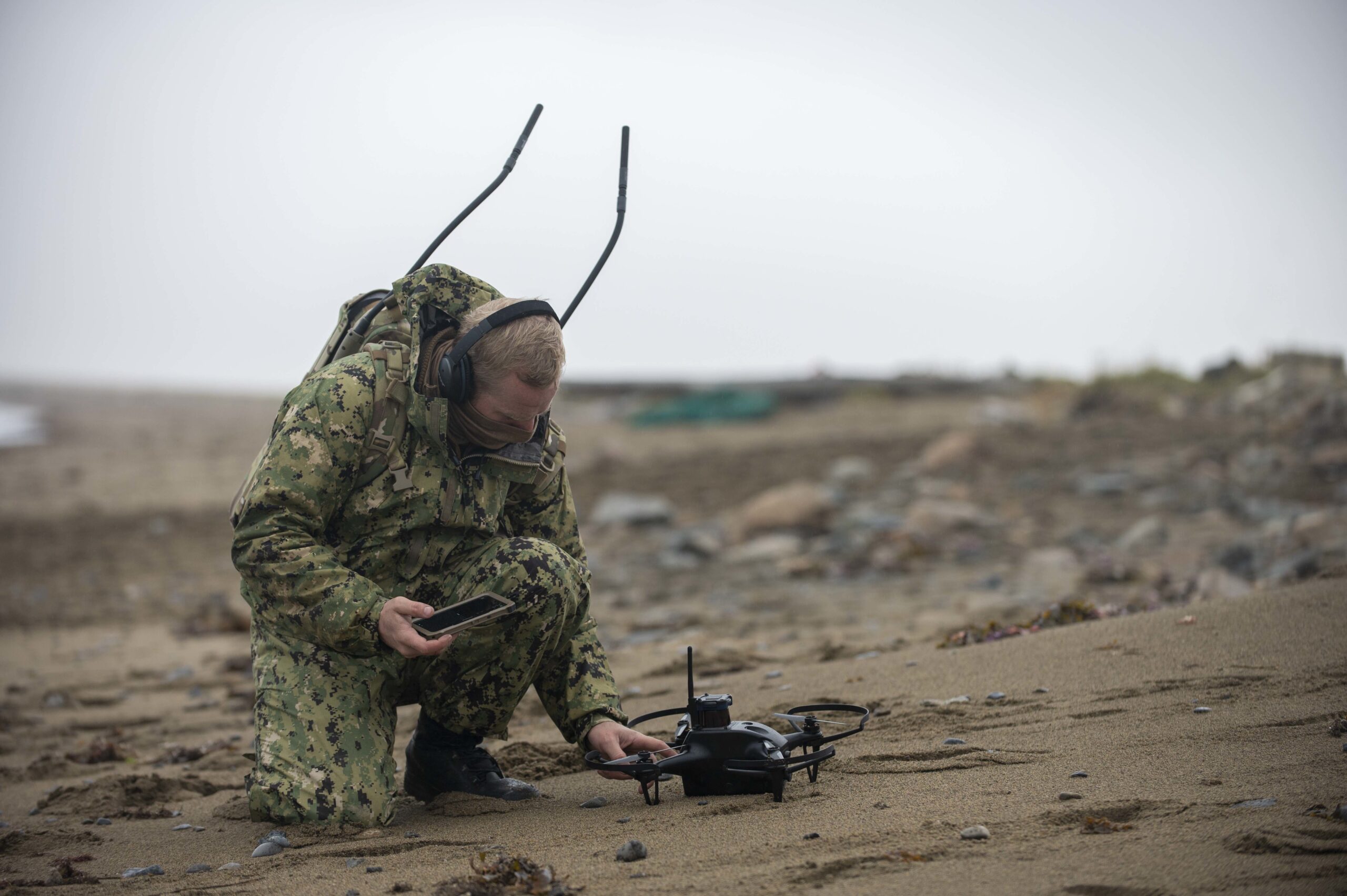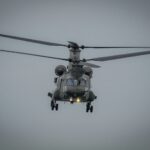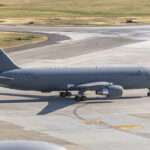Range crews are not often surprised by conditions in Interior Alaska. They are used to below-freezing temperatures at sunrise rapidly changing to muggy noon haze and gusts off the Yukon River that will lay steel antennas sideways. What no one anticipated during the period 25-28 June Project Artemis was how fast two prototype loitering munitions would fold up when all navigation aids go silent. Army’s Yukon Training Area became a sandstorm of electronics: broadband noise jamming the GPS, spoof pulses herding phantom coordinates into mission computers. Operators sat and watched promising flight plans unravel before them; those subsequent crashes now write the script for the second half of Pentagon’s small-drone campaign.
Congress seeded Artemis last autumn with a $16 million insert in the Ukraine supplemental. Lawmakers demanded an answer to one blunt question: Can U.S. forces buy a one-way attack drone that shrugs off hostile jamming inside a single fiscal year? The Defense Innovation Unit, used to tight software sprints, accepted the challenge and wrote a three-page solicitation that left most traditional primes blinking. From 165 proposals, evaluators picked four vendors by March and booked Alaska range time before the snow melted. Compressing design, build, and flight into seven months meant every risk stayed on the wing.
Only two vendors arrived in Fairbanks. AeroVironment trucked in Red Dragon, a rail-launched delta with fold-out wingtips and a shaped-charge nose. Dragoon Technologies flew Sender north on a C-17; that tilt-rotor airframe lifts on four props, transitions to fixed-wing cruise, and swaps warhead modules with four screws. Two Ukrainian teams linked to U.S. software houses remained overseas – a reminder that electronic-warfare work rarely pauses even when factories face missile alerts.
Range control layered the interference profile in steps. First came static noise flooding the civilian L1 and military L2 bands. Then technicians introduced moving deception, blending false Doppler shifts that looked legitimate to a hurried receiver. On the opening sortie Red Dragon climbed cleanly to 600 feet, lost track in ninety-odd seconds, and drilled itself into frozen silt near Moose Hill. The next launch belonged to Sender. Its transition to wing-borne flight appeared stable until spoof code slid into the command stream. The drone’s inertial unit tried to reconcile the mismatch and ran out of filter headroom. It passed fifty yards beyond the target container and detonated in muskeg that swallowed most of the wreckage. By mid-afternoon the test director had four sorties down, two hulls gone, and terabytes of telemetry to explain.
Investigators met that night in a plywood briefing room and wrote the first fault chart. They emphasized that every point already showed up in lab models, yet the scale of Alaska’s failures proved how unforgiving field conditions can be when budgets allow no cushion.
Primary technical gaps identified during the trial:
- Backup navigation cut in too early, giving flight computers no chance to coast through short jamming bursts.
- Direction-finding antennas protected receivers but halved uplink range, starving autopilots of command packets.
- Arctic gusts upset dead-reckoning filters; each reset multiplied position error and drained limited processor time.
- Spoof-rejection logic assumed only one false fix at a time and collapsed when deception arrived on multiple vectors.
Frontline squads watching from berms grasped the implication at once. Infantry cannot wait for perfect skies or assured networks, and a drone that tumbles after a minute of interference is deadweight in a rucksack. That reality has strategic weight because Artemis was created to prove that the United States can build expendable air weapons at the speed Ukraine and Russia now show on opposite sides of the Dnipro.
Ownership complicates the effort. The missile community views attritable drones as guided munitions; aviation officers treat them as aircraft. That split stalls money. DIU can finish a prototype and draft a so-called success memo, yet production starts only when a program office signs on. Engineers who spent the spring tuning autopilots now spend half their week explaining color-coded transition charts to staffs that do not yet hold purse strings.
Cost pressures mount in parallel. Red Dragon uses autoclaved carbon skins that assure repeatability but limit throughput; a single oven can cure six shells per shift. Sender prints polymer ribs on commercial machines and glues aluminum stiffeners by hand, shaving fixture time but adding labor hours. Unit quotes hover near $25 000, far above the $4 000 handmade foam drones Ukrainian teams lose daily over Zaporizhzhia. Line soldiers who have seen that theater shake their heads at American price tags that outstrip the munitions budget of an entire rifle company.
Policy attempted to catch up on 10 July when Defense Secretary Pete Hegseth issued the memorandum titled Unleashing U.S. Military Drone Dominance. By rescinding earlier small-UAS rules, the directive treats drones under fifty-five pounds as expendable munitions and orders every service to embed them inside squad-level load plans. Fresh bureaucracy does not always equal fresh cash, but the paper sets clear deadlines and, for once, measures success in airframes delivered rather than meetings held.
Key provisions in the 10 July directive:
- Establish independent program offices with immediate authority to place production orders outside the traditional Joint Capabilities Integration process.
- Push Government Purchase Card ceilings up to $100 000 for platoon leaders buying compliant drones or spare parts.
- Shift cyber accreditation for small-UAS components from DIU to the Defense Contract Management Agency, adding auditors but removing redundant milestones.
- Direct each service to file a production roadmap for short-range attritable drones by December, including plans to triple existing manufacturing capacity inside eighteen months.
Industry heard the starting gun. AeroVironment stock rose nearly nine percent before lunch on 11 July, and venture funds jammed Dragoon’s phone lines with offers that dangled Series B cash. Optimism matters, yet supply chains still squeeze. Lithium packs demand hazardous-material waivers for every flight leg, and rare-earth magnets in servo motors come largely from Chinese refineries banned under current law. Alternative supply from Brazil and Australia clears compliance but adds cost. Without steady orders, mines hesitate; without feedstock, motor shops go idle.
Environmental factors complicate design choices that looked settled in PowerPoint. Interior Alaska rarely tops forty-five degrees Fahrenheit in early summer. Sender pulls forty watts just to keep its battery sleeve above freezing, trimming endurance by three minutes on an airframe rated for forty. Red Dragon relies on disposable chemical heat pads good for forty-five minutes, forcing crews to tear open fresh packs if a mission slips. Engineers can rewrite navigation code in weeks, but they cannot rewrite thermodynamics. If the drone must wait three days in a foxhole before launch, power budgeting changes and every gram of insulation matters.
Foreign officers invited to observe walked away impressed by the test range yet uneasy about progress. Australia fields Israeli Hero-120s, Poland sends Warmates to Ukraine, and Japan stocks Turkish Kargus for maritime defense. Those systems endure jamming and broad temperature swings today, even if they cost more than foam knock-offs. The United States, they note, still debates who pays for line upgrades while near-peer rivals ship finished drones by the thousands.
China’s FH-901 and Russia’s Lancet-3 frame that concern. Analysts tracking container traffic through Guangdong count more than 3 000 FH-901 units per month, built in plants closer to consumer-electronics hubs than to classical aerospace lines. Russian factories in Nizhny Tagil repurposed artillery assembly jigs to feed Lancet casings faster than they did in 2024. Quantity changes battlefield math: air-defense radars that might survive a dozen loiterers struggle when attacks rise above an hourly hundred. The Alaska outcome shows that Washington has not reached the mass threshold needed to force an enemy defender into that bind.
The Joint Requirements Oversight Council will weigh those facts on 18 July. If service chiefs postpone transition again, factories will not order molds or magnet winders, and unit prices will hover where small budgets cannot bite. DIU penciled a second demonstration at Yuma Proving Ground in October. Desert heat will flip the environmental challenge, stressing cooling loops and battery chemistry but freeing the test from arctic wind. Engineers welcome the contrast because a drone that cannot span both climates will never clear global deployment.
Blue UAS, the compliance list born in 2020 to steer troops toward safe commercial quadcopters, remains a cautionary note. Each software update still passes a separate cyber review, and that bottleneck lets firmware lag behind threat patches. The Hegseth memo hands the process to DCMA, promising more staff and broader waiver authority, though skeptics recall earlier reform waves that died on classification rules and export-control lawyers.
Risk culture stands as the final gate. Artemis crews accepted that prototypes would bury themselves in permafrost; they hosed lithium fires and rolled into the next sortie. Conventional acquisition offices recoil at such images, having spent decades teaching teams to protect million-dollar rounds from every scratch. Disposable air weapons break that reflex. Allowing failure on Tuesday can save lives on Friday, provided budgets absorb replacement and training flows fast enough to stay ahead of the curve.
Capital is already voting. Start-ups pitch printed wings, snap-fit electronics, and acceptance tests that tolerate wide variance. Legacy suppliers counter with precision composites and statistical reliability data. Money flows toward whichever model captures the first multiyear contract. That race no longer sits in a lab; it plays out across factories in Ohio, Alabama, and soon, partners in Mexico looking to backfill motor windings no longer imported from China.
Attritable drones occupy a niche between artillery rockets, which ignore guidance once fired, and crewed aircraft, which return for maintenance. They promise precise strikes without risking pilots but demand stable pipelines more akin to smartphone release cycles than to fighter programs. Without continuous funding, clear ownership, and relentless cost pressure, prototypes will keep dazzling test observers and then vanish into budget slides.
Our analysis shows that the Yukon crashes, though embarrassing, yielded the kind of data that simulation can only approximate. Engineers already rewrite spoof filters, adjust antenna gain, and raise inertial sensor quality thresholds.Whether those fixes translate into pallets on airfields depends less on code than on contract officers willing to sign production orders before the next fiscal close. Squads under fire will not wait. They will reach for whatever system sits on the shelf, stickered with whichever flag moved fastest from demonstration to delivery.
REFERENCE SOURCES
- https://www.dragoon.tech/blog
- https://san.com/cc/pentagon-overhauls-drone-policy-after-alaska-test-failures/
- https://www.diu.mil/latest/four-companies-selected-to-provide-long-range-one-way-unmanned-platforms
- https://defensescoop.com/2025/03/14/diu-artemis-program-contracts/
- https://breakingdefense.com/2025/06/diu-launches-new-project-aimed-at-accelerating-uas-development-offers-20m-prize-pool/
- https://www.defensenews.com/pentagon/2025/07/15/jammed-and-confused-alaska-trial-shows-pitfalls-of-fielding-us-drones/
- https://www.defensenews.com/pentagon/2025/07/10/hegseth-calls-for-extensive-reforms-to-pentagon-drone-buying-practices/
- https://www.avinc.com/resources/press-releases/view/avs-cutting-edge-one-way-attack-uas-secures-diu-backing-under-project-artemis
- https://ruavia.su/since-the-beginning-of-2025-lancet-loitering-munitions-have-eliminated-over-200-pieces-of-ukrainian-armed-forces-uaf-hardware/
- https://greydynamics.com/lancet-3-russias-spear-in-the-sky/



